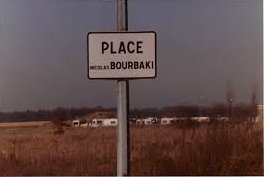Simanaitis Says
On cars, old, new and future; science & technology; vintage airplanes, computer flight simulation of them; Sherlockiana; our English language; travel; and other stuff
NICOLAS BOURBAKI—PHANTOM MATH GUY
WE KNOW the names Archimedes, Euclid, Newton, Einstein and a few others as important personages in science. But some of the most fundamental science of the 20th Century is attributed to a mathematician whose name is rather less familiar. What’s more, no one ever met him.
Frenchman Nicolas Bourbaki invented Ø, a symbol seen by anyone experiencing “New Math.” He also devised a familiar road sign.
Yet Nicolas Bourbaki does not exist.
Or, more properly, Bourbaki exists as the fertile collective mind of a group of 20th Century mathematicians. (Think a mathematical version of classical music’s Les Six.)
The group, mostly French, formed at École Normale Supérieure in Paris in the mid-1930s, its avowed purpose to formulate an axiomatic development of all mathematics.
This foundational work sounds—and is—highly arcane, but an example may suggest its importance. Geometry, as taught to us all, demonstrates the axiomatic approach: Begin with carefully stated assumptions—the definitions of point, line and plane, together with assumptions on how these concepts interact. Then develop new knowledge through deductive reasoning, theorems that follow from these axioms and earlier theorems.
This approach of axioms and deduction has the widest of applications when it has the fewest assumptions. Euclidian geometry is rich in its modeling of physical space, yet is derived from straightforward ideas that are perceptually correct to us. See www.wp.me/p2ETap-Fg for a mini-essay on Euclid’s Elements.
The Bourbaki group met several times a year to discuss fundamentals, one of them—and the subject of their first volume—the idea of set theory.

A selection of Bourbaki’s nine fundamental works forming its Éléments de mathématique series. Set theory (Ensembles, French for “sets”) was the first volume.
The enumeration of objects in a collection certainly seemed a fundamental idea to Bourbaki. What’s more, those seeking to improve math education in the mid-century chose elementary set theory as fundamental in secondary education’s “New Math.”
“How many?” What a fundamental question, so easy to ask.
Or are there any at all? The concept of zero, 0, (a relatively recent idea in mathematics) has a set theory analog in the concept of the empty set, Ø. Bourbaki introduced this concept and notation in its initial volume.

A ∩ B = Ø is a mathematical way of describing the intersection of two sets having no elements in common; its result is the empty set.
The name Bourbaki refers to French General Charles Denis Sauter Bourbaki, adopted by the group in reference to a fake mathematical lecture delivered by a student wearing equally fake facial hair.

Charles Denis Sauter Bourbaki, 1816-1897, French General, whose beard and moustache influenced the group’s choice of name.
Despite his non-personage, mathematician Nicolas Bourbaki has been honored by a geographical locale. The Place Nicolas Bourbaki is in Le Blanc-Mesnil, a northeastern Parisian suburb. Appropriately it’s off Avenue Descartes, near other mathematical honorees. (It’s directly east of Paris Airport—Le Bourget, where Lindbergh landed in 1927.)

Nearby are Avenue Descartes, Rue Nicolas Lobatchevski and Avenue Evariste Galois, all honoring mathematicians. Image from www.les-Mathematiques.net.
In its Séminaire Bourbaki lectures and nine volumes comprising Éléments de mathématique, Bourbaki also devised another special symbol, one that’s found its way onto the roads of the world.
The Dangerous Bend symbol appears in the margin of Bourbaki texts to warn the reader that a particularly subtle argument lies ahead.
Can there be a more useful symbol in all of mathematics? ds
© Dennis Simanaitis, SimanaitisSays.com, 2013


Lobatchevski! I haven’t seen (actuallyheard) that name since the sixties! As used in Tom Lehrer’s song, the “t” is omitted. Wikipedia disputes Tom’s claim that his most important work was tainted with plagiarism.